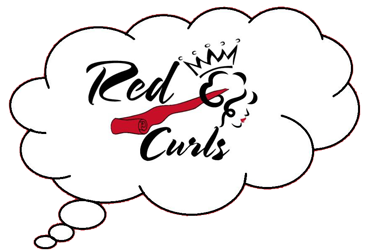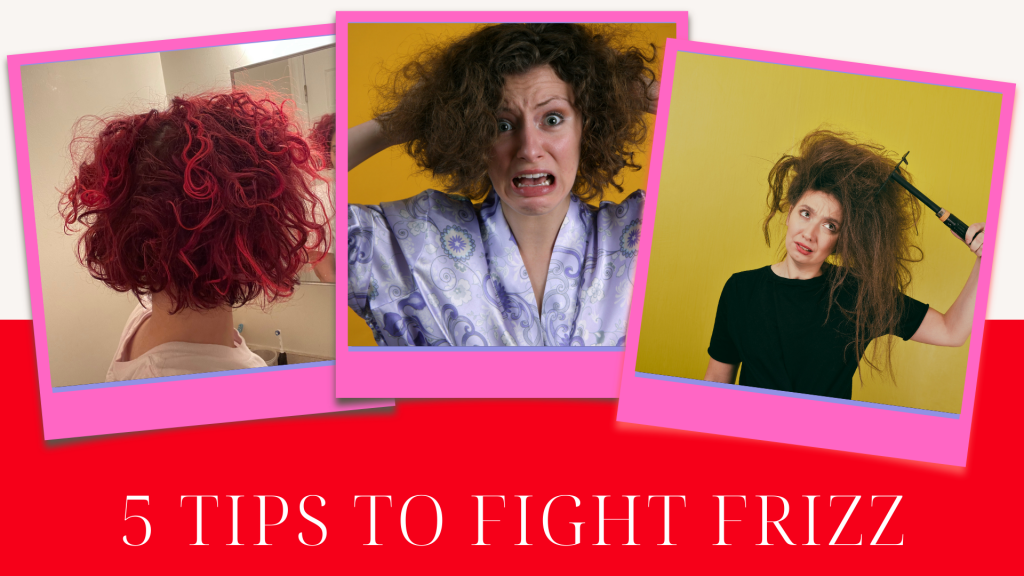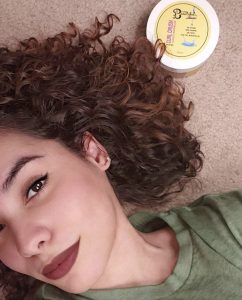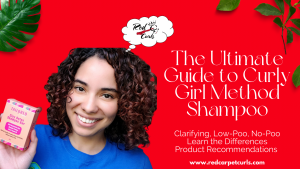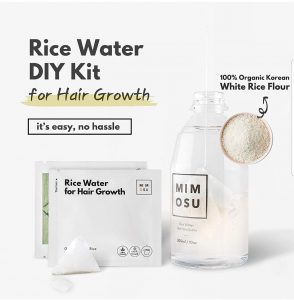Naturally Textured Hair (waves, curls, coils, etc) is always at a moisture disadvantage. Your scalp produces natural oils called Sebum, which is meant to spread around your scalp and down your hair strands to ideally condition, moisturize, and protect them.
The curlier your hair is the more obstacles your texture creates for the sebum. This means the oils are going to take longer periods of time to spread all the way down the hair strands, leaving hair dry, brittle, and vulnerable to split ends and breakage.
While damage is certainly one cause of frizz, it is not the most common cause.
Frizz is most often the result of dry/dehydrated tresses. When your hair strands lack moisture, your hair literally reaches up into the atmosphere in search of moisture.
That’s why I always tell people, it doesn’t matter what texture you have, frizz will always humble and unite us.
Since frizz is such a common hair care concern, let’s break down 5 Tips to Fight Frizz and ensure your best hair days each and every time you touch your tresses.
1) Adapt Curly Girl Method Principles into Your Routine

Adapting the right healthy hair routine is vital for quenching and preventing frizz.
Since Naturally Textured Hair is always at a moisture disadvantage that means you need to supplement moisture much more consistently than straight hair.
Naturally, Textured Hair has different needs than straight hair, as a result, over the centuries those with tighter textures cultivated all-natural and moisture-based routines like the Curly Girl Method.
If you are new to the Curly Girl Method, please click here to learn more before continuing with this article.
The Curly Girl Method focuses on removing damaging practices and ingredients to help repair and maintain the overall health of your hair.
When it comes to building an effective all-natural hair care routine, there are five main steps that will ensure proper moisture/protein balance.
When it comes to your first washday, your routine should look something like this:
- Clarify – always start with a clean canvas, it will expedite your journey by revealing the true state of your hair strand. Before we begin a Curly Girl Method routine, we have to remove all the build-up of past products. Most products on the market contain silicones which encase the hair in a thin invisible layer preventing any new moisture from penetrating the hair strand. Use a sulfate-free clarifying shampoo like the Inahsi Naturals Soothing Mint Sulfate-Free Clarifying Shampoo (Discount Code: REDCARPETCURLS) or the Miche Beauty Detox Clarifying & Detoxifying Shampoo. To learn more about different forms of shampoo, please click here.
- Deep Condition – now that the hair is clean from any build-up it is ready to receive moisture. Clarifying is the strongest form of cleansing and as a result, can leave the hair feeling dry. If you use a heavy-duty cleanser, you need a heavy-duty conditioner to replenish the moisture and begin repairing the hair. It is best to use deep conditioners that contain Hydrolyzed Proteins to repair damaged hair and allow moisture to bind more effectively to the hair strands. This will over time increase moisture retention levels and prevent frizz. Deep conditioners are formulated as the most intensive conditioning treatment meant to improve the overall health of hair. Deep conditioners should be left on anywhere from 10-30 minutes max. Adding heat like the Q-Redew Hair Steamer or the Thermal Hair Care Hot Head helps lift the scales on the cuticle to allow the conditioner to penetrate to the deepest layer of the hair known as the cortex. This over time will repair the hair from the inside out. Deep conditioners should be used at least 1x/a month, preferably 1x/a week. To learn more about the science of deep conditioning and its benefits, please click here.
- Rinse-Out Conditioner – while deep conditioners focus on penetrating the deepest layer of the hair strand, rinse-out conditioners focus on conditioning and moisturizing the outermost layer of the hair known as the Cuticle layer. This is the layer we discuss when we break down hair porosity. Rinse-out conditioners are meant to be left on for 2-5 minutes sealing the scales on the cuticle, quenching frizz, and improving shine. Rinse-out conditioners can be used daily.
- Leave-In Conditioner & Gel – Naturally Textured Hair needs two things to ensure frizz-free curl definition each and every time you style those two things; Hydration and Hold. Our hair is like a plant, which means the only substance that can truly hydrate hair is water. This is why the first ingredient in any moisturizing product you use should be water. This is also why I always recommend adding products to soaking wet hair to lock in that moisture. A leave-in conditioner is a perfect primer for frizz-free hair. After your hair has adequate moisture, you must lock in that moisture and definition with gel. Gel’s primary purpose is to provide hold to your hairstyles, but it’s not the same hard crunchy feeling we remember. Once hair is fully dry you scrunch out the gel cast to reveal the soft, bouncy, frizz-free definition.
- Oil – the purpose of oil is to seal in all the moisture you just added to your hair during your entire routine. You can use 3-5 drops to do a scalp massage, encouraging new hair growth and increasing volume. You can also use a few drops to scrunch out the gel cast and add an extra layer of protection against moisture loss. To learn more about oil please click here.
For my visual learners, you can check out the YouTube live session I conducted on a 5-Step Healthy Hair Routine below:
2) Alternate Between Clarifying & Moisture-Based Cleansing Options

Moisture starts at the beginning of your wash day. Your cleansing choice is the perfect opportunity to add more moisture to your washday.
Shampoo is a word that is often feared or misunderstood when it comes to the interwebs so let’s clear up some of that misinformation now, to help you make the best choice for your hair.
There are different categories of shampoo, as discussed in my Ultimate Guide to Curly Girl Method Shampoo blog post. Let’s start with the big boy on the block known as Clarifying Shampoo.
Clarifying shampoos are the strongest type of shampoo, that’s why I call them the big boy on the block. Clarifying shampoos are formulated with the strongest surfactant (detergent) group known as Anionic Surfactants. This class (look at me getting fancy and technical with it) of surfactant contains two groups within it, sulfate and sulfate-free groups.
Since naturally textured hair is already dry, you do not need damaging sulfates to remove the last bit of moisture you have. Sulfate meeting dry hair will always equal split ends and breakage.
Instead of using sulfates, naturally textured hair should use sulfate-free anionic surfactants like Sodium C14-C16 Olefin Sulfonate. It looks like sulfate but it is not. It is the strongest sulfate-free clarifying surfactant you can use, meaning it will remove all types of build-up including silicone, hard water, and product build-up.
Clarifying the hair at least once a month is vital to keeping the build-up away and keeping your hair clean enough to allow your products to penetrate deep into the strand instead of sitting on top.
My favorite clarifying shampoo is the Inahsi Naturals Soothing Mint Sulfate-Free Clarifying Shampoo(save $ by using discount code: REDCARPETCURLS).
It contains Sodium C14-C16 Olefin Sulfonate, so it will remove all build-up safely. But I also love that it contains moisturizing ingredients like water, glycerin, and aloe vera. It also contains hydrolyzed oats, which is super important because hydrolyzed protein is small enough to penetrate past the cuticle layer, all the way to the deepest layer of the hair strand known as the Cortex.
Hydrolyzed proteins help moisture bind better to hair. So, if you’re looking for a clarifying shampoo that will not only effectively deep clean your hair but also improve its overall health over time, look no further! I even use it to remove chlorine from pools during the summer.
Too much of a good thing becomes a bad thing over time.
There is such a thing as over-clarifying and this too can lead to split ends and breakage. Remember this is the big boy on the block, and he doesn’t have to make an appearance too regularly.
Starting with once a month is fine, and if you have fine or wavy hair you can bump it up to twice a month to help deal with product build-up.
Since the winter winds steal moisture from the hair, between clarifying washes you should be using more moisture-based gentle cleansing options such as low-poo, no-poo, and co-wash.
Low-poos are gentle cleansing weekly shampoos designed to deliver more moisture to the hair than it does focusing on deep cleansing. These types of shampoos cleanse without stripping hair of its natural oil.
Low poos is simply a nickname given to gentler cleansing shampoos to state the fact that the shampoo suds up upon application, not all shampoos will foam up.
One of my favorite low-poos is the Inahsi Naturals Soothing Mint Gentle Cleansing Shampoo (can you tell I am OBSESSED with Inahsi Naturals products? Btw the discount code works for ALL Inahsi Naturals Products!).

The low poo contains gentle surfactants such as Cocamidopropyl Betaine and Sodium Cocoyl Isethionate to cleanse the hair. I also love that it contains moisturizing ingredients like water, glycerin, aloe vera, and Guar Hydroxypropyltrimonium Chloride to moisturize my hair.
I also love using the Tailored Beauty Coconut Creme Shampoo!

Besides smelling like absolute heaven, this low-poo contains gentle cleansing detergents such as; Sodium Lauroyl Methyl Isethionate, Cocamidopropyl Betaine, and Sodium Cocoyl Isethionate. To make it super moisturizing, this product contains ingredients like water, aloe vera juice, glycerin, and Guar Hydroxypropyl chloride. It’s also infused with coconut oil which cleanses and strengthens hair without leaving it feeling stripped.
Last but certainly not least is the most luxuriously moisturizing no-poo I have ever used across my over six-year healthy hair journey. Also known as the Shiny Leaf Castor Oil Shampoo!

This moisture-rich shampoo is my go-to for a boost of healthy hair growth. That is because of the amazing all-natural ingredients found in the formulation. This shampoo is enriched with Jamaican Black Castor Oil. Castor oil has excellent moisturizing and restorative properties. It contains essential fatty acids and proteins needed to repair damaged strands to restore hair health with each use. This shampoo contains gentle yet incredibly moisturizing surfactants like Sodium Methyl-2 Sulfolaurate / Disodium 2- Sulfolaurate and Cocamidopropyl Betaine which produces a thick lather giving this shampoo the insanely pampering and moisturizing experience. This shampoo will gently cleanse while delivering a polished shine that lasts. Check out my YouTube Unboxing and Tutorial by clicking here.
Remember you can always purchase Shiny Leaf products directly from the website (use discount code: REDCARPET15) or for easier shopping and saves just click here to head to my Amazon Storefront.
Next, we move on to No-Poo.
These are gentle cleansing shampoos formulated to have the consistency of a conditioner for maximum moisture. Meaning it’s a super moisturizing shampoo that will not foam up.
One of my favorite no-poos to use is the Veracious Curls Cleanser (save $ by using discount code: REDCARPETCURLS).

This oil-free, conditioning cleanser is designed specifically for Naturally Textured Hair to moisturize, cleanse, and melt away knots and tangles. This creamy cleanser promotes hair strength and growth by maintaining a healthy PH level, preventing dryness, and unclogging hair follicles. This product alone will revitalize your scalp with organic fruit extracts while leaving hair soft and manageable. Speaking from experience, this amazingly moisturizing shampoo feels like you’re co-washing your hair. Paired with a scalp brush, it leaves the hair feeling clean but most importantly moisturized!
Last but certainly not least in the gentle cleansing category is Co-wash. A co-wash is not exactly a shampoo, although it does lightly cleanse hair.
Co-washes are conditioners formulated with gentler surfactants (often Cationic surfactants) to lightly cleanse the hair but most importantly provide more moisture to dry hair. Co-washes are perfect to use in-between clarifying washes and even after the gym to remove sweat. Co-washing is perfect to battle dry winds trying to steal all the moisture from your hair.
3) Deep Condition Regularly

Deep conditioning is one of the most important if not the most important steps in your hair care journey. Consider your deep conditioning sessions to be a non-negotiable covenant you make with your hair when you begin your natural hair journey.
Why are your deep conditioning sessions so important?
Deep conditioners are formulated to be the most intensive conditioning treatment. They are formulated with (smaller and lighter weight) moisturizing ingredients. These conditioners are meant to be left on between 15-30 mins per session, no more (especially not overnight)! That is because the ingredients are meant to penetrate past the Cuticle (outermost layer of the hair strand), all the way to the Cortex(innermost layer of the hand strand). The cortex is responsible for over 90% of the overall hair strand’s strength. Your deep conditioner focuses on moisturizing and strengthening this significant layer of the hair.
That is why deep conditioners are responsible for improving the overall health of your hair. If you moisturize and strengthen the hair strand at its deepest layers, you will improve the health and elasticity of your hair protecting it from split ends and breakage.
Deep conditioners should be used once a week, but during the winter months, you may find that your hair is still thirsty, bump your sessions up to twice a week and see how your hair responds.
If you have fine or wavy hair and see deep conditioning this often is too much for your hair, bump it down to once every two weeks. This is why I say deep condition regularly, as opposed to putting a definitive schedule to it. Everyone’s hair is different and has different needs. You just need to learn to decipher the language of your own hair.
For those with low porosity hair, make sure your hair is clarified of build-up since this is a common issue due to the scales on your cuticle layer. If your hair is clean of build-up the deep conditioner can penetrate the strands more deeply. Also, since low porosity hair has an issue with the scales not lifting to allow moisture in (resulting in dry hair), you need to assist the scales in their lifting process by adding indirect heat like the Q-Redew Hair Steamer or a Microwavable cap like those available from Thermal Hair Care Hot Head, and Thermal Vibes. Indirect heat helps lift the scales on the cuticle allowing moisture to penetrate more quickly and effectively.
Looking for deep conditioner recommendations? Click here to check out my Deep Conditioning blog post.
4) Use paper towels and T-Owl Towels to dry hair

When we first begin our Natural Hair Care Journey we are told to replace our damaging cotton towels with microfiber towels. Cotton material rubs against hair strands encouraging friction and frizz. Cotton towels also cause tangles which lead to split ends and breakage.
Not only are microfiber towels more absorbent than cotton towels, but they also smooth the cuticle layer of the hair to help prevent frizz. Microfiber towels are perfect for those with long thick hair since they remove moisture quickly from the hair.
If you have thin/fine hair like mine, microfiber towels tend to remove too much water causing frizz. If this is also your struggle consider switching to everyday kitchen paper towels or my favorite tool the Tee-Owl Towel.
It is made with thin t-shirt material to remove the perfect amount of moisture without all the frizz microfiber towels typically cause.
Paper towels are incredibly absorbent, perfect for removing excess moisture and product. If you have color-treated hair and worry about messing up your towels with your hair color, paper towels are the perfect solution. Since I get my Cherry Red Pintura Highlights done every 2-3 months, color often bleeds onto fabrics. To save myself the laundry headache, I use Bounty Paper Towels.
5) Style on Soaking Wet Hair
https://www.tiktok.com/@redcarpetcurls/video/7178934710293384490?is_copy_url=1&is_from_webapp=v1
When you are looking to style for frizz-free definition, you need to style/apply products to soaking-wet hair.
Whenever you use an all-natural (a.k.a effective) conditioning product, you will always see water as the first ingredient. That is because hair is like a plant remember? It loves water because it’s always lacking moisture. You want to seal in as much moisture as you can when you style to prevent having to restyle the following day. This pattern eventually leads to product build-up issues.
When you apply products to soaking wet hair, you lock in the dripping water and the water contained in your product. This will properly hydrate the hair and the moisturizing/sealing ingredients in your products will lock in that moisture for longer periods.
Styling on soaking wet hair allows you to use less of your product but with better results. So this one tip will save you money, time, and frustration.
To effectively style soaking wet hair, many people prefer to style while still in the shower. This means completely rinsing out your conditioner, running the water over your hair, and then applying your styling products. When you style on soaking wet hair you will notice bigger curl clumps.
If you have fine/thin hair or wavy hair that gets weighed down quickly, this method will still work for you if you follow tip #4 right after this step. The paper towels or Tee-Owl Towels will remove all the excess moisture, allowing you to have weightless frizz-free results.
